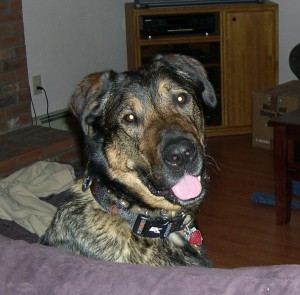Bloat: Who Knew?
January 31, 2011
Have you ever felt bloated after eating? You try to belch or expel gas any way you can, because you know you’ll feel better if you do. You may even consider vomiting to relieve pressure and you try that. But, you can’t do either, and the more your body goes through the digestion process, the more the gases build within. There is no relief. And then comes the pain.
Now imagine a dog going through this, but because of the way the canine’s “innards” are situated, the stomach starts twisting and flipping. Now, there is not only no relief, but blood supply is now being cut off to vital organs as the ends of the stomach are cinched off and it continues to expand. The dog is now in great pain and going into shock. Without immediate medical intervention, there is no hope of survival. Death comes quick, in just a few hours.
This is called canine Gastric Dilatation and Volvulus (GDV), more commonly called “bloat”. Our Khori just went through this, though we caught it early enough that veterinary professionals could save him from the immediate danger and stabilize him. As of this writing, Khori was stable all weekend since the two “bloats”, and he is awaiting today’s surgery (gastropexy) which will prevent future GDV. Thank God.
Bloat/GDV is common in large breed dogs. Its cause is unknown, though various medical theories exist. It is deadly when untreated and the second most common killer of dogs behind cancer. Here are some measures you can take to help prevent bloat in your dog:
• Give smaller meals (i.e., instead of 1 per day, give 2 or 3).
• Put water in dry food to prevent rapid expansion of wet food within the stomach.
• Find ways to slow the eating process. Special dishes to slow fast eaters are available in pet stores. You can also use very large stones or rubber balls within the dish so the dog must eat around these objects.
• Prevent exercise or any kind of excitement for at least 2 hours after eating. (It is at this time when bloat commonly presents).
• Regarding elevation of the food dish, the jury’s still out. Some vets recommend elevating the dish; others do not. Speak with your vet if you are not sure.
Our vet told us this morning that gastropexy surgery is fairly common as a preventative measure. In fact, dogs with high risk for bloat (i.e., Great Danes), are considered candidates for gastropexy early on – even during the spay/neuter surgery – because the risk is so high in their lifetime.
As for us, we had heard about bloat – specifically in Great Danes – so never gave it a second thought until Friday night, when Khori began unsuccessfully attempting to belch and vomit as his stomach grew to the size of a basketball. Hopefully, this post will help you to prevent the same thing or worse from happening to your beloved pet.
